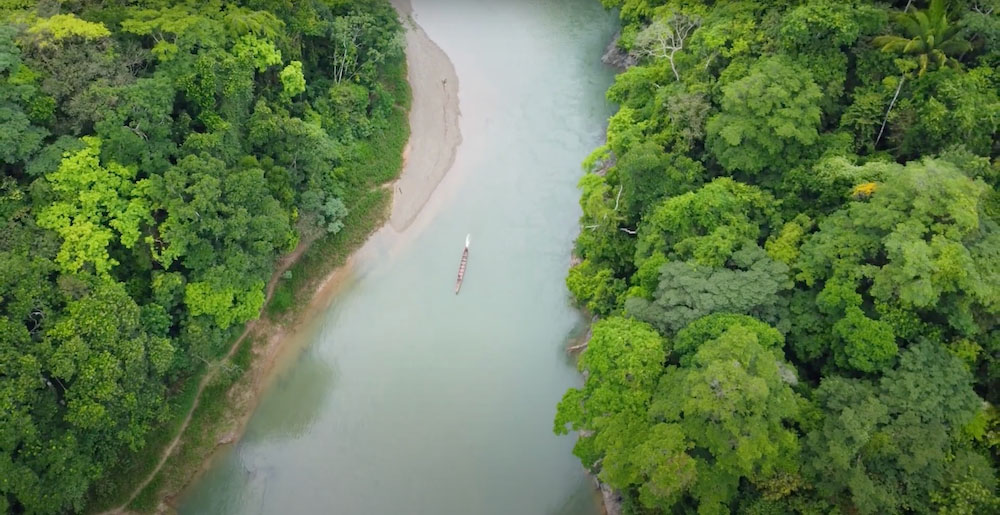Claudio is responsible for bringing tourists to his community. Up until early 2025, that meant riding a boat across the River Chagres to the nearest place with Internet or a phone line, where he would arrange the day’s visits with tour guides living in the city. He is an Emberá, an Indigenous group living in Panama.
He says that they used to live off their own crops, like plantains, rice, and yuca. They sold the surplus to merchants on boats that would take it to Panama City, which helped fund whatever else the community needed. That was until 1985, when the Panamanian government declared the region a national park.
The measure helped preserve nature, but also meant the Emberá were forbidden from growing their produce. This forced them to find an alternative way to survive, eventually landing on cultural tourism. Although this is now their main activity, it was only in 2025 that they were able to manage it online, from their own community.
Like the Emberá, 2.6 billion people—about a third of the world’s population— still don’t have Internet access. This gap reflects more than a lack of infrastructure; it’s a complex web of barriers including affordability, relevance, quality of service, and digital skills.
These divides exist between countries, within countries, and even within neighborhoods. Urban centers may enjoy high-speed access while rural or remote communities remain unserved. In many cases, the people left offline are also those who face other forms of exclusion, like lower incomes, limited education, discrimination, or displacement.
Who Are the Unconnected?
Connectivity gaps often fall hardest on marginalized groups. Indigenous peoples, women, and displaced populations experience the intersection of limited infrastructure and structural barriers.
Displaced people, including refugees and migrants, often live in areas with inadequate services, unclear legal status, and temporary planning horizons. Women face gaps driven by affordability, social norms, and unequal access to education and skills. Indigenous communities may live in isolated areas and face language or cultural barriers even where networks exist.
The result is that those who could benefit most from access to education, markets, health services, and civic participation—some of the opportunities the Internet offers—are least able to get online. Just like the Emberá have been, historically.
“Indigenous communities are the most forgotten. Some live 20 to 30 minutes from the city and yet don’t have Internet access,” said Julio Lezcano, director of the Panama Chapter’s Community Networks Committee.
Why Are So Many People Unconnected?
Over the past decades, governments, the private sector, and multilateral institutions have extended connectivity to much of the world. Yet traditional approaches have struggled to reach the hardest-to-connect areas. Commercial models often do not work in low-density or low-income regions. In these contexts, return on investment is low, and deployment costs are high, driving commercial service providers away.
Even when infrastructure is present, affordability, relevance, and trust can prevent people from going online. These issues are structural. Without innovative approaches, the gap will remain.
In Panama, for example, a commercial service provider would have to install infrastructure through a dense forest and a large river to bring connectivity to the Emberá communities—an investment that would cost a lot and wouldn’t be financially profitable. That’s why we need alternative approaches to connect the unconnected.
How Can We Fix This?
Community-centered connectivity offers a way forward. This encompasses connectivity solutions built for, with, or by the people who use them. They include community networks, cooperatives, and Indigenous-led projects. They rely on local leadership, affordable and appropriate technology, and governance structures that reflect community priorities. And, more importantly, they serve their communities’ needs, not profit margins.
These solutions address three key barriers to getting everyone online:
Availability – extending infrastructure to places where none exists.
Affordability – keeping costs low and manageable for the community.
Adoption – building trust, skills, and relevant content.
By involving communities directly in design, deployment, and maintenance, these models do more than connect people. They enable participation and ensure that connectivity meets real needs. They are adaptable, which allows them to remain sustainable in areas where traditional models just won’t fit.
This is how the Emberá, in partnership with the Internet Society Panamá Chapter, were able to build and maintain their Internet connectivity. Local experts supported the community through the design and implementation process, getting them online in early 2025. Claudio is now in charge of running the network—and he knows how to maintain it.
But to make these solutions available to everyone, we need structural change.
Making Universal Connectivity Possible
Reaching universal connectivity will require action from many actors—governments, regulators, communities, civil society, and the private sector. Community-centered connectivity can only thrive in an environment that supports it. That means removing barriers and creating policy strategies that make it easier for communities to connect themselves.
Some steps include:
Inclusive policy and regulation – ensuring that rules support community-led initiatives, including simplified licensing models and legal recognition for small-scale operators.
Smarter spectrum management – allowing shared or dynamic use of spectrum so that communities can access the airwaves they need without prohibitive costs.
Access to funding – making universal service funds and other financing tools available to non-traditional providers, including cooperatives, Indigenous-led networks, and social enterprises.
Capacity building – investing in training and resources so that communities have the skills to design, deploy, and sustain their own networks.
Partnerships – fostering collaboration between communities, governments, the private sector, and civil society to share knowledge and resources.

